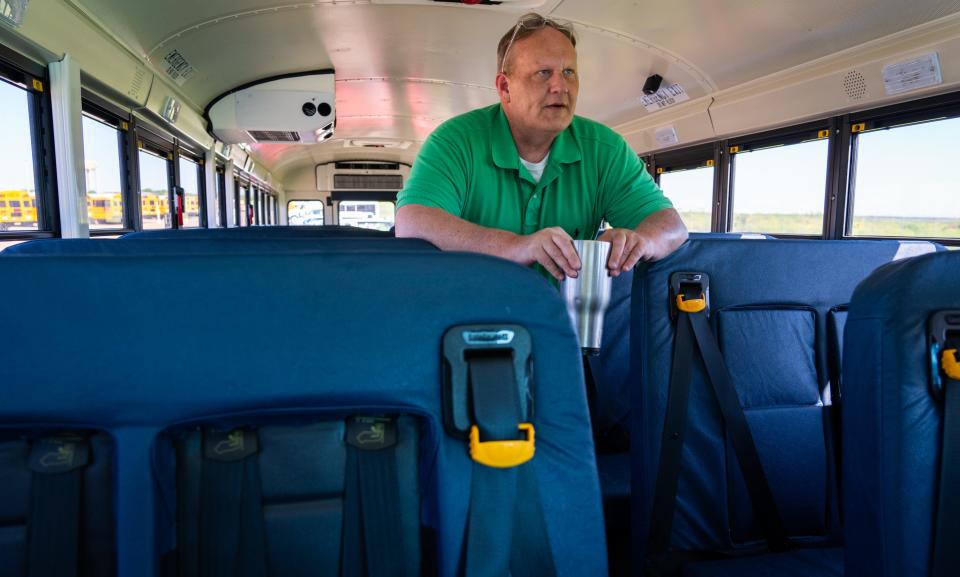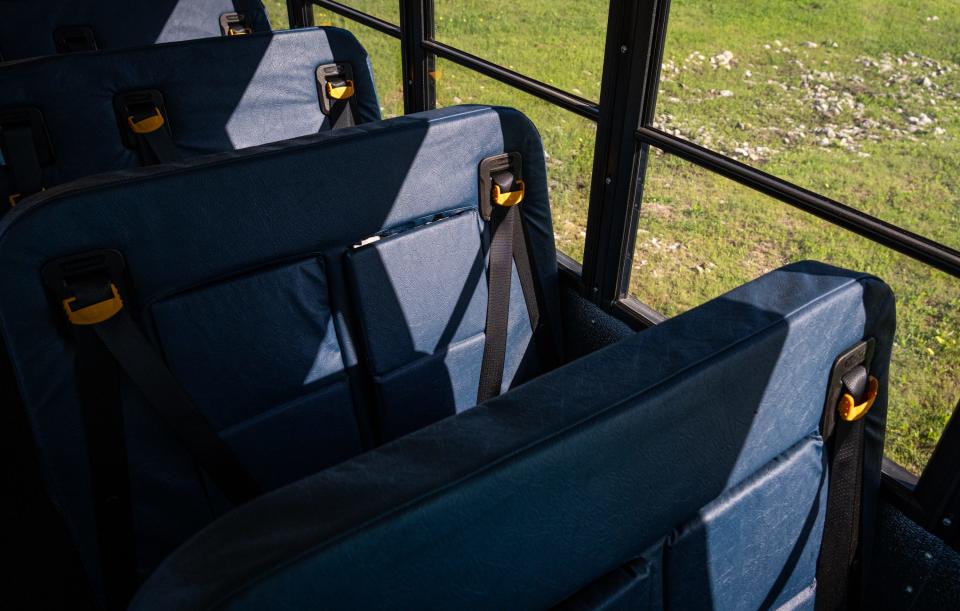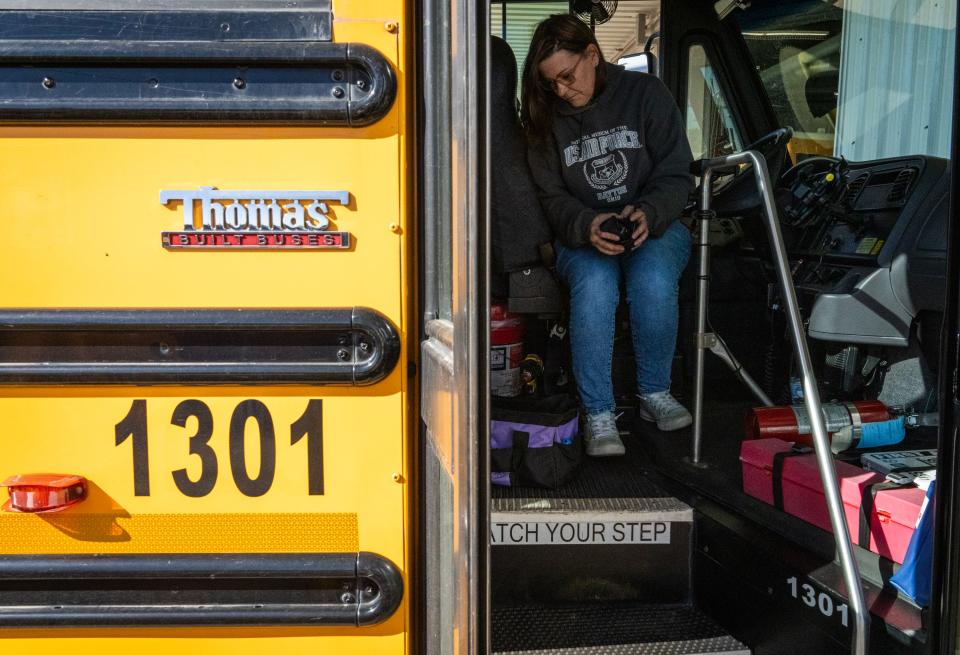'Horrified and heartbroken': Hays school bus crash raises safety concerns after deadly crash
A collision involving a Hays school bus last month that left two people dead, including a five-year-old, has sparked concern among parents about the safety of school buses, especially after having learned that the vehicle carrying students and teachers from Tom Green Elementary lacked seat belts.
Despite the fatal March 22 wreck, however, safety experts told the American-Statesman that children are statistically safer in a school bus during a crash compared with most passenger vehicles, but they cautioned that seat belts would make safety conditions more secure.
“The tall, padded seats on school buses help to keep the occupants contained during some types of crashes — really just frontal and rear impacts, when the occupants would be thrown directly forwards or backwards at the time of impact,” said Julie Mansfield, co-director of the Center for Child Injury Prevention Studies at Ohio State University.
But parents like Megan Owen, whose children attend Elm Grove Elementary in the Hays school district, were devastated to learn that the bus involved in the crash didn’t have seat belts. She said she had no idea schools were still using buses that lacked that safety equipment, leaving her “horrified and heartbroken” about the fatal crash.
“Every new bit of information, it just got worse and worse and worse,” Owen said. “The final straw for me was, ‘Oh my God, it didn't have seat belts.’ How is that possible? That is completely unacceptable.”
The Hays school bus crash happened about 2 p.m. March 22 on Texas 21 near its intersection with Caldwell Road in Bastrop County where a concrete pump truck veered into the opposite traffic lane and struck the bus taking 44 prekindergarten students and 11 adults back to Tom Green Elementary from a field trip to a zoo. The concrete truck hit the bus, causing it to roll over, and leaving 5-year-old Ulises Rodriguez Montoya dead.

The truck also hit another vehicle traveling behind the school bus, killing its driver, 33-year-old Ryan Wallace, a University of Texas doctorate student who was weeks away from defending his dissertation.
Jerry Hernandez, the 42-year-old driver of the concrete truck, was arrested March 29 and charged with criminally negligent homicide. It's unclear if seat belts would have prevented any death or injury in the crash.
Investigative reports and court documents released publicly focus on Hernandez's statements after the crash to a Department of Public Safety trooper. He told the officer he only had three hours of sleep the night before and had a "small amount of cocaine" the morning of the crash, according to his court affidavit.
Texas seat belt law
In Texas, only school buses purchased after 2017 must have seatbelts.
Lawmakers passed Senate Bill 693 that year, requiring the safety equipment on school buses but also carving out exceptions for districts that face financial burdens in purchasing the vehicles with seatbelts, which can run about $160,000 each, said U.S. Rep. Sylvia Garcia, a former state senator who authored the 2017 law.
“A tractor has a seatbelt. Golf carts have seat belts. Planes have seat belts,” said Garcia, D-Houston, adding that Texas should provide money to school districts to purchase buses with seat belts.
“It's part of the whole education we're providing for children,” she said. “It's about their safety.”
The state provides a chunk of transportation funding to school districts, but many purchase new buses through voter-approved bonds, which districts use to pay for construction and renovation projects.

School bus safety
School buses are designed with a concept called “compartmentalization,” said Mansfield, the co-director of the Center for Child Injury Prevention Studies.
That type of school bus design provides passengers with a protective envelope consisting of strong, closely-spaced seats, which have energy absorbing seat backs, according to the National Highway Traffic Safety Administration.

In the 1970s school buses underwent a design transformation to make them brighter and more visual on the roadways, said Kristin Poland, deputy director of the Office of Highway Safety at the National Transportation Safety Board.
The safety board investigates transportation-related mishaps and practices across the country, and makes recommendations to improve safety. The board, however, doesn’t have power to compel government agencies to take action.
"It’s understandable for parents to decide to drive their own children to school after a school bus crash, but school buses are designed to protect children,” Poland said. “... They're always safer in the school bus, whether they have seat belts or not."
Buses also are bigger and heavier than passenger cars, and harder to move. Often they are higher off the ground than a typical passenger car, said Jeri Skrocki, the Hays school district safety and security chief.
If a passenger car ran into a school bus, the hood of the passenger vehicle would hit essentially below a child’s feet, she said.
“If we're talking about side impacts or rollovers, (however), there's nothing to keep the children from moving side to side or up and down,” Poland said.
But, the Highway Traffic Safety Administration has found that the compartmentalization bus design, along with added safety features, such as seat belts, "make these vehicles the safest on the road."
Are seat belts in school buses common?
During the 2022-23 school year, 717 of almost 1,600 school buses in Texas had lap and shoulder seat belts, and another 308 just had lap belts, according to Texas Education Agency data collected from 978 of the roughly 1,200 school districts across the state.
In Texas, school districts and open-enrollment charter schools are required to report annually to the TEA the number of bus crashes they had in the preceding school year, according to the state Education Code.
According to TEA data, fatal school bus crashes are rare in Texas. Between 2009 and 2023, seven children and two adults have died in crashes involving school buses. Over that same time period, 98 students and 59 adults were seriously injured in school bus crashes.

What's next for the Hays district?
The Hays bus involved in the March 22 crash, which is a 2011 model, was one of 15 buses without seat belts that was set to be replaced with vehicles equipped with seat belts, according to the school district.
On Thursday, district transportation staff applied decals to some of its 21 new buses with seat belts. By the end of the month, all regular route school buses should have seat belts, the district said.
Officials also plan to replace the dozens of buses in the district's back-up fleet over several years. The district typically needs at least 40 of those buses daily.
Once a bus is equipped with seat belts, it’s important that parents emphasize to their students the importance of wearing those belts, Skrocki said.
“A driver has got to pay attention to the road in front of them and not kids wearing seat belts behind them,” Skrocki said. “It really becomes incumbent on parents to parent and make that part of what the standard is.”
This article originally appeared on Austin American-Statesman: Hays school bus safety, seat belts concerns raised after fatal crash
